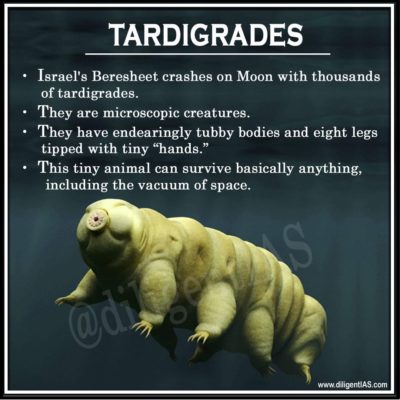Israel’s Beresheet Crashes on Moon with thousands of Tardigrades 13/08/2019 – Posted in: Daily News – Tags: Israel's Moon mission, Israeli spacecraft - Beresheet
TARDIGRADES
For: Mains
Topics covered: About Israel’s Moon mission, Israeli spacecraft – Beresheet, Tardigrades
News Flash
The first privately funded mission to the Moon has crashed on the lunar surface due to the failure of its main engine.
- The Israeli spacecraft – called Beresheet – attempted a soft touchdown, but suffered technical problems.
- It’s unknown if the archive — and the water bears — survived the explosive impact when Beresheet crashed.
Aim
The aim of the mission was to take pictures and conduct experiments.
Israel’s Beresheet Spacecraft
- Beresheet was a robotic lander.
- It didn’t transport astronauts, it carried human DNA samples, along with the aforementioned tardigrades and 30 million very small digitized pages of information about human society and culture.
- The tardigrades and the human DNA were added to the mission a few weeks before Beresheet launched.
Why send tardigrades to the moon?
- Tardigrades, also known as moss piglets, are microscopic creatures measuring between 0.002 and 0.05 inches (0.05 to 1.2 millimeters) long. They have endearingly tubby bodies and eight legs tipped with tiny “hands.”
- This tiny animal can survive basically anything, including the vacuum of space.
- Tardigrades can survive conditions that would be deadly to any other form of life, weathering temperature extremes of minus-328 degrees Fahrenheit (minus-200 degrees Celsius) to more than 300 F (149 C).
- They also handily survive exposure to the radiation and vacuum of space.
- Another tardigrade superpower is their ability to dehydrate their bodies into a state known as a “tun.”
- They retract their heads and legs, expel the water from their bodies and shrivel up into a tiny ball — and scientists have found that tardigrades can revive from this dehydrated state after 10 years or more.
- So if any creature were capable of surviving a crash-landing in space, it would probably be a tardigrade.
Source: BBC
Also, read more daily News
- Pradhan Mantri Kisan Urja Suraksha evam Utthaan Mahabhiyan (PM-Kusum)
- New GDP series to align with Global Method
- First global analysis of Nematodes
- Lake “Kajin Sara”
- Reusable Rockets
- Henley Passport Index 2019
You are on the Best Online IAS preparation platform. You are learning under experts.
We are present on Facebook- Diligent IAS, LinkedIn- Diligent IAS, YouTube- Diligent IAS, Instagram- Diligent IAS. Get in touch with us

